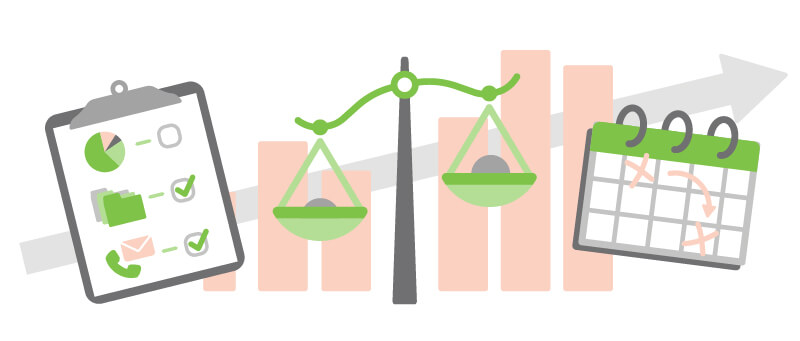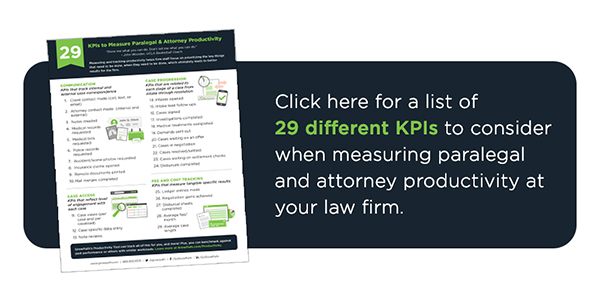What KPIs Should Law Firms Measure to Increase Staff Productivity?

It’s hard to think of a scenario in which a law firm would not want to become more productive. It can help struggling firms survive challenging times and flourish afterward. It can help leading firms put competitors in the rearview and become market leaders.
No matter what situation your firm is in, you may be able to increase your overall productivity by measuring some Key Performance Indicators in your data. Every practice has its pressure points.
Measure From the Top Down
Employee productivity KPIs should necessarily correlate to firm productivity. So, the first thing you should measure is your firm’s productivity. How you do this depends on your particular practice area. We’ve discussed firm KPIs before.
You obviously want to get the most for your client in every case, not settle them for pennies on the dollar simply to make an arbitrary deadline. By the same token, you don’t want to spend inordinate amounts of time squeezing cases for a few pennies more – and delaying client compensation – when your attorneys’ time can be more productive elsewhere. Decide on a KPI that works best for your firm and go from there.
Want to Increase Employee Productivity? Use This Method and These KPIs…
Given the differences in legal practices, there may be completely different milestones that cases reach as they flow through your process. Here are the steps to determining and measuring vital KPIs and how they can help you increase productivity. For this example, we’ll use a PI firm.
Step 1: Choose Your KPIs
In a personal injury firm, case movement (also known as file progress) is an excellent KPI for productivity because it aligns with your clients’ interests and there are a few obvious milestones for that case type as each progresses. Some examples of case movement KPIs for PI firms include:
- Sending Demands Out
- Ordering Medical Records
- Moving Files From Investigation
These are excellent KPIs for PI paralegals because they represent things that are in the paralegals’ control. They can own these KPIs.
There are other metrics you can use as well. Let’s say that you want another KPI to measure because the “waiting” phase of cases is too unpredictable. An example would be a client who is in treatment and is taking a long time to reach maximum medical improvement (MMI). You can add a KPI for direct communication with this client during this period: phone calls, text, or emails sent at certain intervals.
To reiterate, KPIs should be actions the employee can control.
Are the KPIs Different for Attorneys?
A little. For attorneys, file progress is also important. If you imagine every part of the process – from intake to resolution – as a bucket, you want those buckets to balance. If there are too many cases in one bucket, it creates a bottleneck. So, when a new case arrives, you want one case to move from its initial stage to its second stage, one from the second stage to move to the third stage, and so on, including a case moving to resolution.
Some excellent productivity-increasing KPIs for attorneys include:
- Sending Demands Out (shared with paralegals)
- Cases Resolved
The KPIs build on one another from paralegal to attorney to firm. Case movement KPIs for paralegals feed into cases resolved KPIs for attorneys, and so on.
Step 2: Benchmark Performance
Once you have measured those KPIs for at least a quarter, but preferably more, you’ll know who’s doing work. There’s nothing subjective. This is not who you “think” is being productive. This is who is actually sending demands, ordering records, moving files, and resolving cases: measurable work accomplished.
Benchmarking reveals who your top performer or performers are. You’ll see who’s being the most productive. This enables you to reward those top performers. It also enables you to…
Step 3: Compare Results and Act
Compare your top performers with the average. What are they doing that enables them to perform at such a high level? Compare the lowest performers to the average. What can you learn from the top performers to help these paralegals increase their productivity?
Why Case Movement KPIs Increase Productivity
The data does not lie. Using case movement KPIs is a great way for firms to see the flow of work, where it’s going well, and where it’s bottlenecked. It can enable you to spot who is overwhelmed and who has bandwidth.
Most of all, it gives your employees an idea of how they’re being evaluated. And by spotting lower performers, you can train them up, and help them grow their productivity – or move on if necessary. Don’t guess: set targets and watch your employees hit them.
The Right KPIs Increase Productivity – The Right Software Helps You Measure the KPIs
These productivity-increasing KPIs will open the door to more profits for your firm. Can you measure them? Can you report and evaluate the data? And can you do it fast enough to make a difference? The ultimate capability is being able to record every email, text, and phone call. You need to see the notes associated with those touches, and know when cases are moving from phase to phase.
This isn’t a sales pitch, this is a fact. Without the data and the tools necessary to analyze it, you’re back to managing with hunches and your eyeballs. That wasn’t the best way to do things even before the pandemic and the necessity of remote work. If your case management software isn’t cutting it, maybe there’s another way to increase your firm’s productivity.
